Article 1 of the U.S. Constitution vests Congress with the sole authority to authorize federal spending and revenue.REF With the federal government now covering 333 million people and the world’s largest economy, this is both an awesome power and a tremendous responsibility.
The exponential growth of federal activity and spending since the start of the 20th century has allowed many legislators to forget (or ignore) the proper boundaries of the federal government. One of the best examples of this regrettable trend was the tremendous growth of earmark spending beginning in the 1990s.REF Earmarks, which are typically project-specific spending requests made by Members of Congress as part of the annual appropriations process, became a source of ridicule and scandal until bipartisan public anger resulted in an earmark ban in 2011.REF This ban remained in place until legislators resumed the practice with fiscal year (FY) 2022 appropriations.REF
Congress has already increased earmarking dramatically, from $9 billion for 4,970 earmarks in FY 2022 to $15.3 billion for 7,234 earmarks in FY 2023.REF Information about earmarks can be difficult to track down, with lists placed in supplementary “explanatory statement” documents and key project details dispersed across the personal websites of members who made requests.REF
Earmarks in the FY 2022 and FY 2023 omnibus appropriations packages flow from a relatively small number of programs and bureaus. Due to foundational flaws shared across these earmarked programs, Congress should substantially reduce spending on the programs even if the earmark ban returns. This would improve the nation’s shaky fiscal health, reverse a long-standing trend of federal encroachment on state and local responsibilities, and reduce political corruption that has no business existing in the greatest nation on earth.
Root Cause: Unchecked Federal Bloat
The federal government, once relatively constrained in size and scope by the Constitution, grew exponentially in size and scope during the 20th century. Many of the largest departments today in terms of spending, regulatory authority, and employees—such as the Departments of Education, Energy, Health and Human Services, Housing and Urban Development, and Transportation—did not even exist in 1950. The expansion of federal activity served to centralize power both through direct federal control and through an increasing amount of influence from federal grants given to state and local governments.REF
Increasing federal dominance over the nation leads to many glaring policy problems, including:
Government Capture by Special Interests. The enormity of the federal government presents a shortcut for narrow interests to obtain privileges.REF Since the burden of federal spending is spread across the entire population, legislators can lavish billions of dollars on a particular industry, region, or ideological cause without drawing national ire. Once a benefit is created, special interests have strong incentives to lobby Congress to retain and grow the benefit, whereas taxpayers have a much smaller incentive per person to lobby against a particular benefit. Accordingly, lobbying efforts to maintain or expand federal power far outweigh lobbying efforts to shrink or devolve federal power. It should not be surprising that legislators have responded to the pressure (and political incentives) by steadily expanding federal activity.
Seemingly Intractable Waste, Dysfunction, and Overspending. The vast expanse of the federal enterprise has allowed many problems to fester for years. For example, the nonpartisan Government Accountability Office’s High Risk List report series highlights dozens of significant problems with each iteration.REF One of the items in the inaugural 1990 edition of the report, “Medicare questionable claims,” is still present under the heading of Medicare “improper payments,” with 89 open recommendations for this chronic problem area alone.REF The size of the federal government far exceeds congressional capacity (or appetite) for oversight, and additional federal expansions compound the problem.
Federal Encroachment on State and Local Governments, Businesses, and Civil Society. Many policymakers assume that Washington should be involved in solving nearly every social or economic problem. This ignores the nation’s long history of robust civil society organizations, free markets, and local governments finding solutions that best fit the specific needs of people and communities. Federal intervention crowds out these other actors, and one-size-fits-all federal approaches are rarely optimal (and are often actively counterproductive) in a nation as large and diverse as the United States.REF
Earmark spending is emblematic of each of these problems.
Earmarks Often Go to Special Interest Groups. Lobbying activity and related corruption scandals were a significant factor behind the previous earmark ban.REF However, increased transparency in the new earmark process does not change the fact that congressional offices are inundated by earmark lobbyists as businesses, local governments, and activist organizations vie for a share of federal loot.REF
Earmarks Are Often Obscenely Wasteful. The gold standard for earmark waste was the Gravina Island Bridge, which became known as the “Bridge to Nowhere.” It garnered national attention in the mid-2000s due to nine-digit costs despite benefitting only a tiny number of people in a remote part of Alaska.REF Recent earmarks remain wasteful. FY 2022 earmarks included $1.6 million for “equitable growth of shellfish aquaculture industry” in Rhode Island, $4.2 million for “sheep experiment station infrastructure improvements” in Idaho, and $3 million for a Mahatma Gandhi Museum in Houston.REF None of these are an appropriate use of federal funds, especially as the nation’s fiscal situation becomes increasingly perilous.
Earmarks Are Directed Toward Projects that Ought to Be State, Local, or Private Responsibilities. The House Appropriations Committee uses the phrase Community Project Funding when referring to earmarks. Earmarks relate almost exclusively to community-level items such as sidewalk improvements, public housing, museum facilities, and industrial parks. However, the most appropriate place to make decisions about the worth of a community-level project is within the community itself, whether through local government, businesses, or civic organizations.REF By offloading project costs onto Uncle Sam, these groups can shirk core responsibilities and at times obtain funding for marginal projects that would otherwise fail due to insufficient local support.REF
Congress would be fully justified in resuming the earmark ban to combat corruption, reduce the time and resources that congressional offices devote to earmark requests, and reduce the ability of appropriators to use earmarks as a logrolling tool for increased spending levels.
However, the previous earmark ban did not fully resolve problems related to federal overreach. Instead, programs previously subject to earmarks marched on with tens of billions of dollars in annual funding, only with project decisions made by state and federal bureaucrats rather than Members of Congress. Therefore, it is vital for Congress to both ban earmarks and eliminate or significantly reform the programs that the earmarks flow from. If a renewed earmark ban did not ultimately reduce federal spending and control, it would be only a limited victory.REF
An examination of both individual FY 2023 earmarks and their programmatic origins reveals a tremendous amount of corruption, waste, and inappropriate federal activity. The following sections highlight key programs and noteworthy earmarks, organized by appropriations subcommittees.
Agriculture, Rural Development, Food and Drug Administration
Rural Programs. The Department of Agriculture operates several subsidy programs focused on rural areas. Of these, there is significant earmarking for the Rural Housing Service, Rural Utilities Service, and Rural Community Facilities Program.
Each of these programs is an exercise in political box-checking, with Members representing rural areas claiming credit for providing “free” benefits. Meanwhile, the real-world rationale for rural subsidies is severely lacking.REF
- The Rural Housing Service, initially created to provide credit to farmers in the mid-20th century, now primarily offers means-tested housing credit for rural homeowners. This creates housing market distortions, and the program is very poorly managed.REF Meanwhile, Rural Housing Service earmarks show that Congress sees the program as a slush fund for rural areas, with projects ranging from “economic development” (i.e., corporate welfare) to environmental conservation to local government facilities.
- The Rural Utilities Service was created during the Great Depression at a time when many rural areas lacked electricity. That has not been a problem since shortly after World War II, and private energy providers have the capability and incentives to ensure that rural Americans can keep the lights on.REF The program has branched out into broadband services, which also ought to be left to the private sector.REF
- The Rural Community Facilities Program is clearly a slush fund, and many Senators seek to take advantage of it. Senate earmarks for this program include museums, theaters, local infrastructure, and local government facilities.
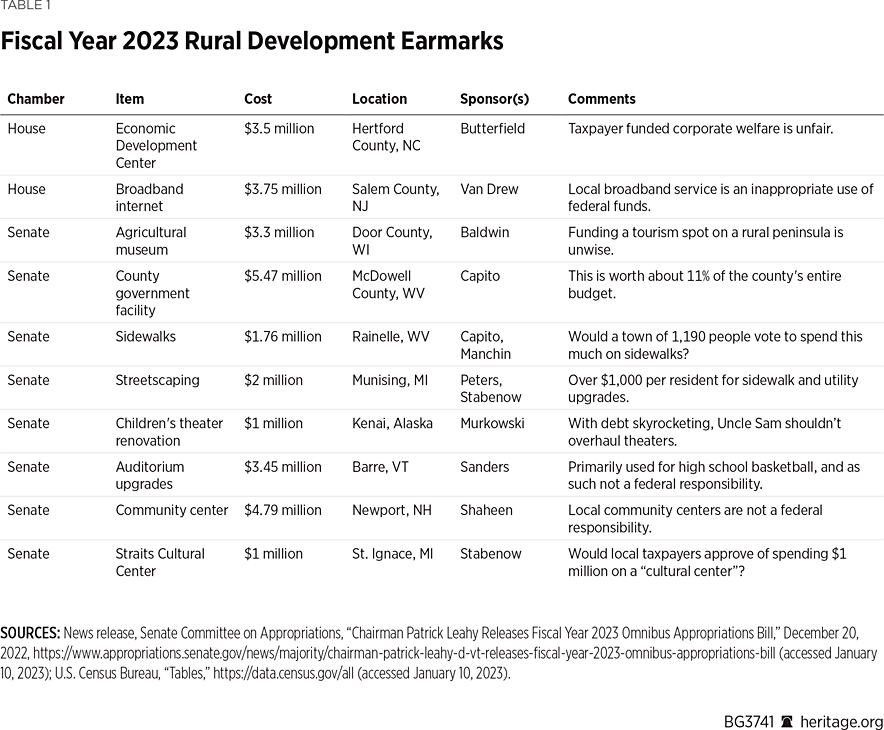
Each of the items in the above table would require significant debate if local governments and community groups had to fully finance the projects themselves. Using the federal appropriations process allows them to mostly (or completely) avoid cost-benefit analysis and property tax hikes at the expense of taxpayers elsewhere in the country. This is wasteful and unfair.
Energy and Water Development
Energy Projects. The Department of Energy subsidizes most types of energy production either directly in the form of grants and tax credits or indirectly in the form of paying for research activity. Solar, wind, and other types of “green” energy receive a significantly disproportionate share of federal energy spending in relation to the amount of energy they produce, though subsidies for oil, gas, and coal are also problematic.REF For too long, the Department of Energy has attempted to micromanage a sector of the economy for the sake of realizing political goals, with a dismal track record to show for billions of dollars in annual spending.REF
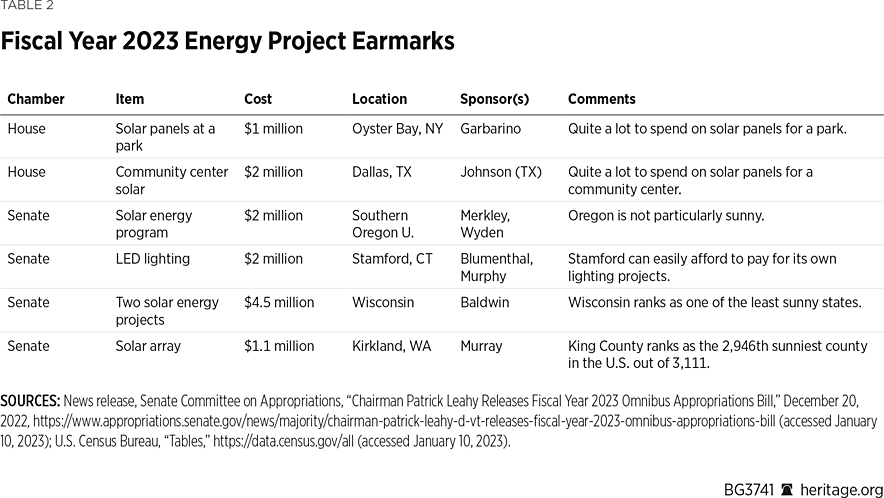
Examining earmarked spending on energy projects serves to magnify the problems involved with federal activity in the sector. For example, Members obtained expensive solar energy projects for low-sunlight states such as New York, Washington, and Wisconsin.REF The economic viability of earmarked energy projects is a tertiary concern behind political jockeying and virtue signaling.
Financial Services
Small Business Administration. Benefitting from positive public sentiment surrounding small businesses, the Small Business Administration (SBA) duplicates a variety of privately provided services—including financing, training, and counseling—with added layers of bureaucracy and taxpayer subsidization.REF
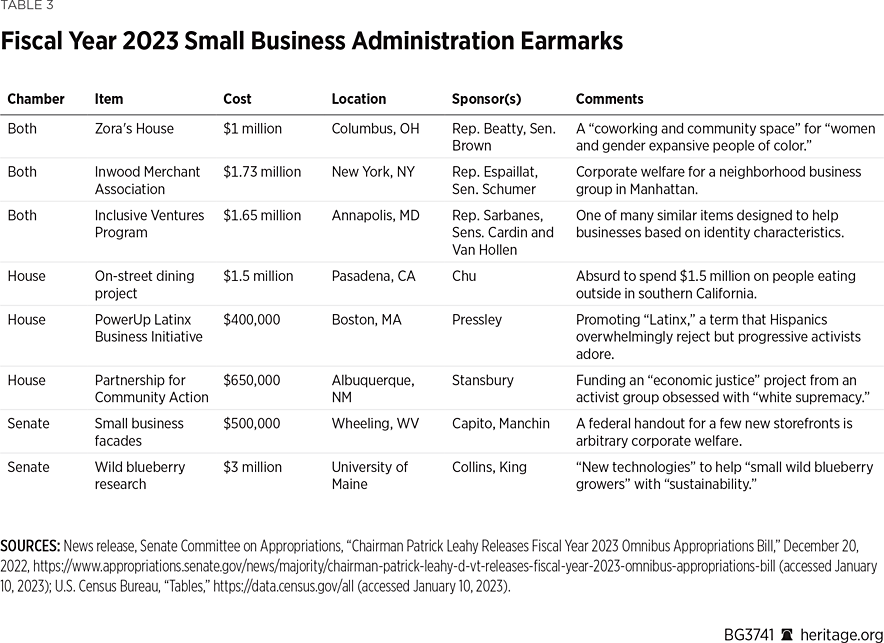
As the table above highlights, earmarks for the SBA are a mixture of corporate welfare, woke identity politics, and bizarre boondoggles. While Congress should dump these wasteful earmarks, they should also scrutinize whether the SBA delivers anywhere near enough economic benefit to justify billions in annual funding.
Interior, Environment
Environmental Protection Agency Water Grants. The bulk of the Environmental Protection Agency’s (EPA’s) budget goes toward grants to states and tribal authorities. This is another example of the federal government subsidizing local responsibilities and adding bureaucratic costs and delays rather than adding value. Responsible localities that build and maintain water systems end up subsidizing localities that wait for a turn at Washington’s cash spigot.
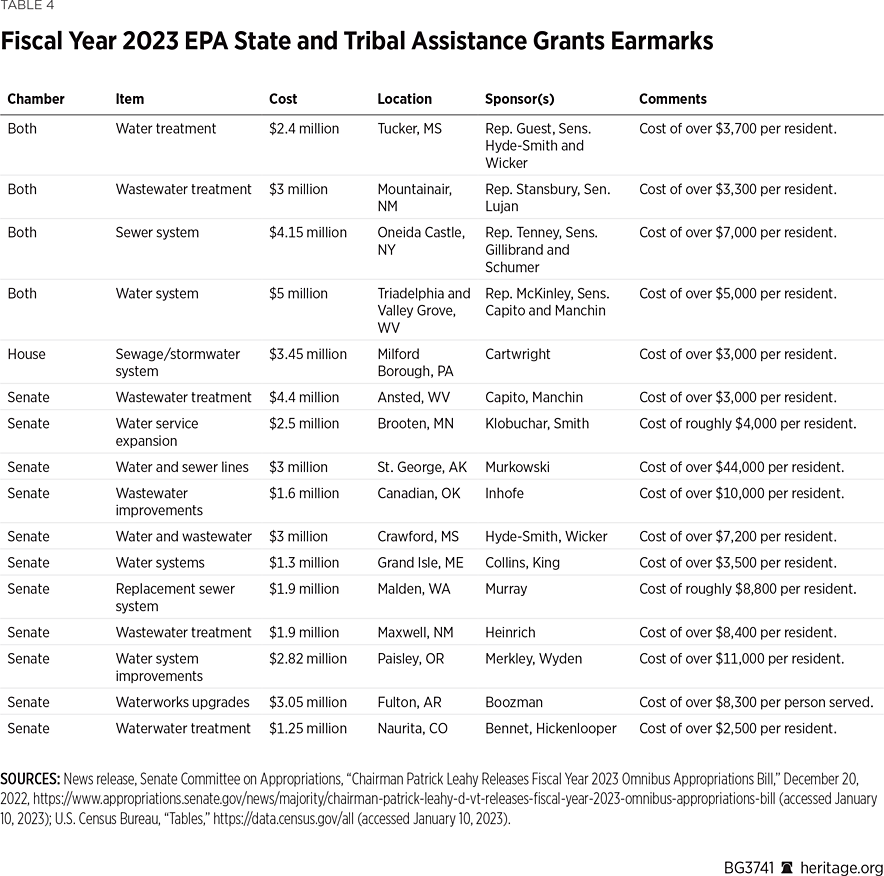
As the above table demonstrates, many of the water earmarks included in FY 2023 appropriations amount to huge windfalls for small towns and villages at the expense of taxpayers from the rest of the country. The most glaring example of this is St. George, Alaska. A tiny and extremely remote island with a shrinking population of 67 people, St. George will receive $3 million (over $44,000 per person) for water and sewer lines from its earmark. Perhaps the project would bring $44,000 in value for each of the residents, but since they are the only ones benefitting, they should bear the cost. Incredibly, St. George will receive another $2.5 million for a harbor project by the Army Corps of Engineers, for a total of over $82,000 in earmark spending per person.
Labor, Health and Human Services, Education
Education Programs. The U.S. Department of Education has been a wasteful mistake ever since its founding in 1980, and federal subsidies for public schools serve to prop up a dysfunctional and often corrupt status quo.REF The COVID-19 pandemic further exposed many significant problems with public education across the country and magnified the urgency of reforms that would enhance educational choices for families.REF
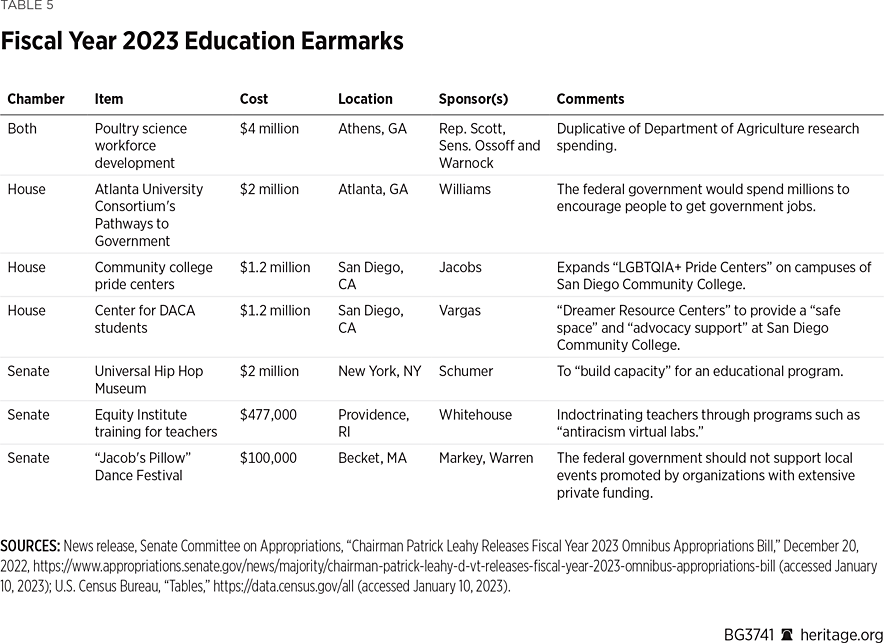
Earmarks for federal educational programs provide a window into the skewed priorities of some Members of Congress. The FY 2022 omnibus included funding for the RAISE Institute at Ohio State University, which is designed to support professors who are explicit activists on racial matters.REF FY 2023 earmarks include the ridiculous (Hip Hop Museum) alongside several that advance a left-wing social agenda, such as training for teachers from the Equity Institute and subsidizing “LGBTQIA+ Pride Centers” on campuses.
While eliminating education earmarks would be a step in the right direction, it is also vital to broadly decrease federal support for the educational establishment. This would reduce the obscene federal debt burden facing the nation’s children and make it easier for states to move away from the union-dominated status quo.
Transportation, Housing and Urban Development
“Highway” and Transit Infrastructure. The Highway Trust Fund (HTF) is painstakingly designed to maximize political benefits by allowing elected officials at all levels of government to be lauded for their involvement in projects ranging from the practical to the niche to the absurd.REF The 2021 Infrastructure Investment and Jobs Act (IIJA) ramped up spending through the HTF, and appropriations earmarks provide an avenue for Members of Congress (and lobbyists) to access billions in deficit-financed funding per year for their preferred cuts of transportation pork.REF
One could be forgiven for assuming that earmarks under the Highway Infrastructure Programs category would primarily go toward improving the interstate highway system. Not only is this not the case, but reality is almost the exact opposite. For decades, Congress has added carve-outs within the HTF that allow funds to go toward hyper-local projects such as bike lanes, sidewalks, and even “road diet” or “complete streets” projects that aim to reduce automobile usage for the sake of various progressive causes.REF
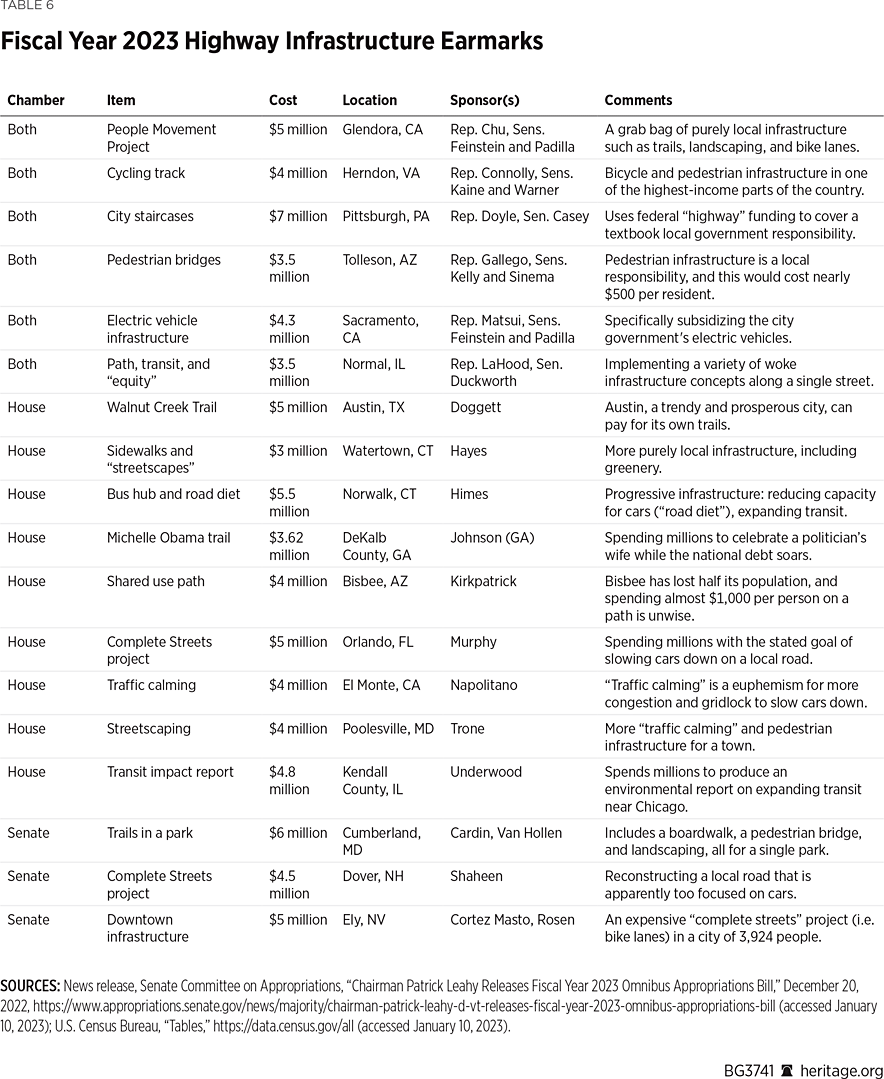
As the above table demonstrates, Members of Congress are all too willing to throw taxpayer dollars at extremely questionable earmarks that are completely disconnected from the original purpose of the HTF. From staircases in Pittsburgh, to a Michelle Obama Trail in Georgia, to multi-million-dollar environmental impact reports, it seems as though almost anything is allowed within the “highway” category. However, it is worth noting that even a large portion of conventional road projects in the category are for main streets and commercial boulevards that ought to be state or local responsibilities.
Congress should finally recognize that there is no longer a serious justification for massive federal involvement in surface transportation financing. State governments and the private sector are more than capable of maintaining and enhancing the interstate highway system, and local governments should stop seeking handouts for parochial projects. The federal government can help facilitate this by lowering the national gas tax, reforming rules that prevent tolling on many interstate highways, and eliminating regulations that needlessly increase construction costs.REF
The largest diversion from highways in the HTF is for mass transit, which accounts for a small and shrinking portion of America’s transportation usage yet reaps a growing portion of federal transportation spending. The IIJA provided a larger percentage increase to transit than it did to highways despite a sharp drop-off in transit usage following the COVID-19 pandemic.REF
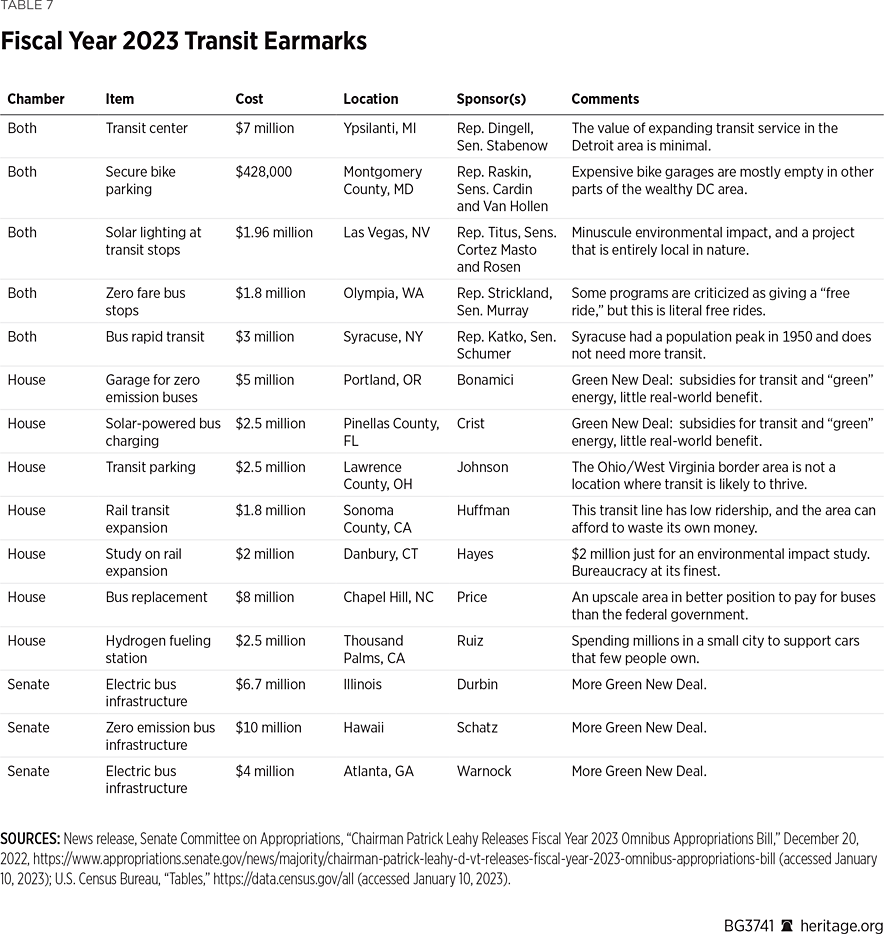
Transit funds exist as a sop to the political left, and this is reflected in the types of projects selected for transit earmarks in the table above. From “green” buses to transit expansions in places where existing transit is underused to fancy bike garages, transit earmarks are virtually guaranteed to deliver minimal value to taxpayers while allowing urban Members of Congress to brag about their bacon.
Ultimately, federal subsidies for mass transit are a barely disguised jobs program for unionized transit workers, who form a cog in urban political machines and receive inflated compensation packages.REF While Congress should significantly reduce spending on highways, it should eliminate transit spending entirely.REF
Community Development. The Department of Housing and Urban Development’s Community Development Fund (CDF), which primarily flows into the Community Development Block Grant program, is perhaps the most blatant political slush fund in the entire federal government. It was originally intended to target blighted urban areas, but legislators can now use it to pay for practically any project so long as it is sufficiently local, making CDF a perfect negative example of Congress prioritizing narrow constituencies rather than truly national needs.REF
In FY 2022, Congress dipped into the CDF to fund a staggering number of wasteful and inappropriate projects, including “cultural placekeeping” in San Francisco, “recreational infrastructure” in North Carolina, and a Gandhi museum in Houston.REF
The FY 2023 CDF earmarks remain as wasteful and inappropriate as the year before. Further, the volume of problematic CDF projects is so staggering that it requires categorization to properly comprehend.
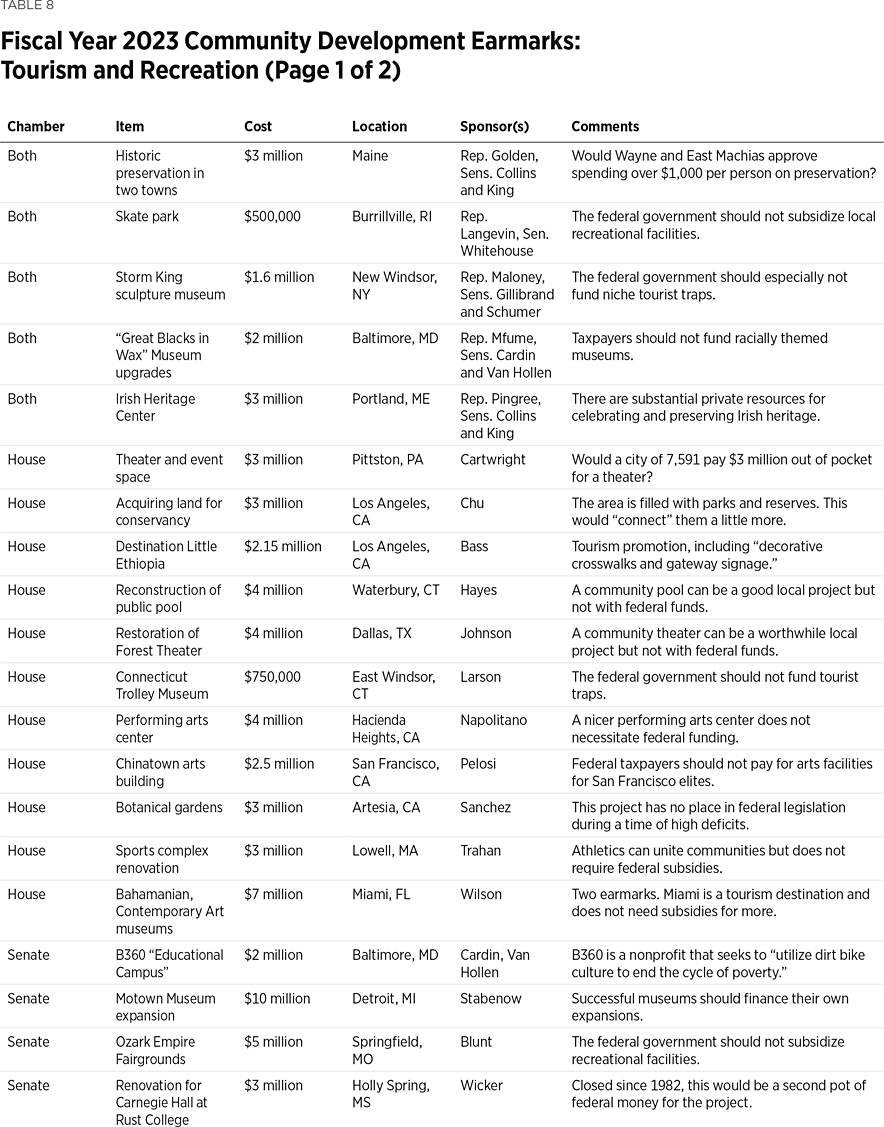
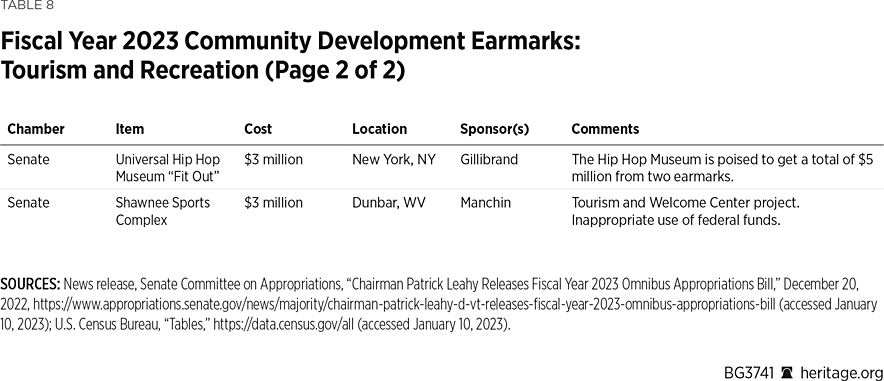
At a time when federal deficits are expected to exceed $1 trillion per year for the foreseeable future,REF directing federal funds toward local recreation and tourism projects ought to be beyond the pale. As the above table shows, legislators have requested a slew of earmarks for theaters, ethnic neighborhood cultural trappings, pools, sports venues, museum amenities, a skate park, and even a Baltimore organization that purports to “utilize dirt bike culture.”
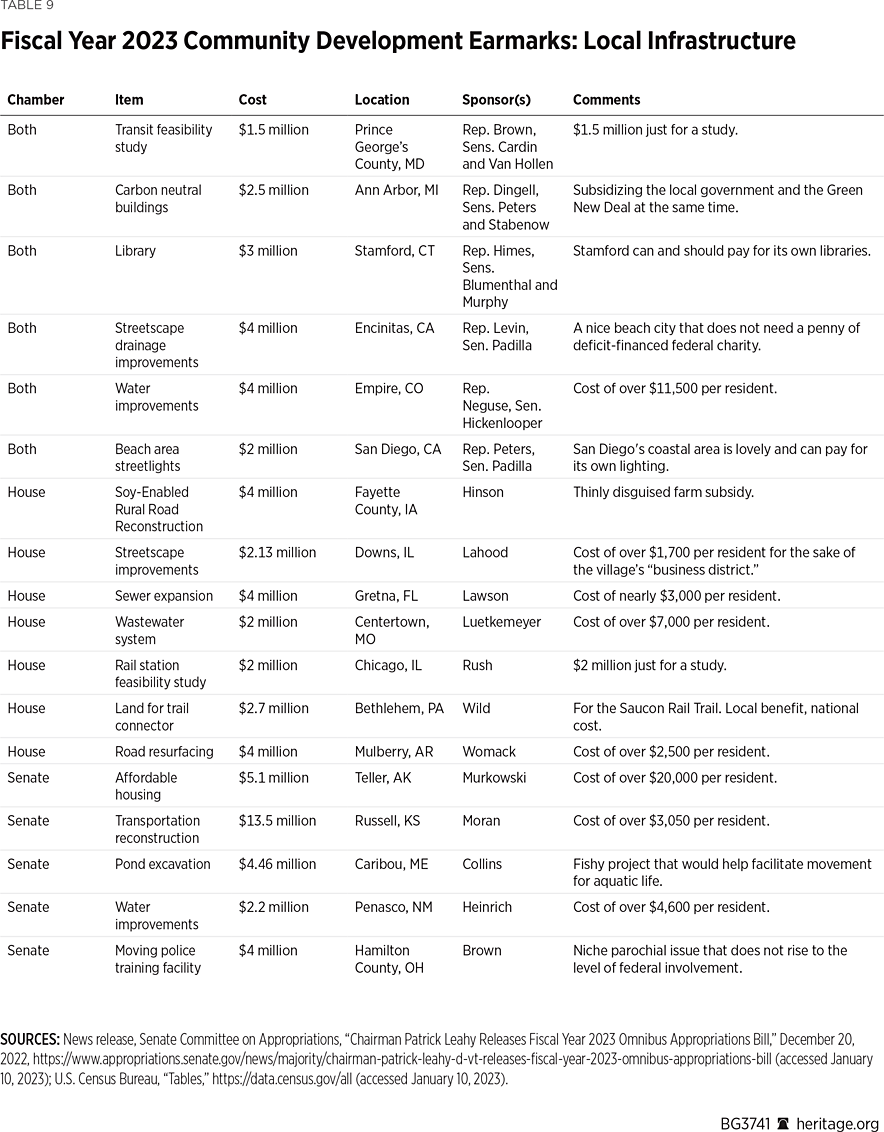
Another major subcategory of CDF earmark spending is local infrastructure. As the above table demonstrates, these fall prey to the same mistakes as other infrastructure program earmarks. In some cases, earmarks lavish millions on projects for very small towns. In other cases, there are absurdities such as $4 million for a pond excavation in Maine, project feasibility studies that cost millions apiece, and “soy-enabled rural road reconstruction” in Iowa.
It is worth pointing out the large number of CDF earmarks for affordable housing projects. There can be no denying that housing costs are reaching crisis levels in many metro areas across the country, and some traditionally affordable areas are also experiencing severe housing inflation.REF However, the main culprits behind housing affordability problems are not a lack of earmarks or government subsidies. Instead, the blame should lie with overly restrictive local regulations that have stifled badly needed housing construction in most major urban areas coupled with federally subsidized housing loans that pump excessive amounts of money into the sector.REF
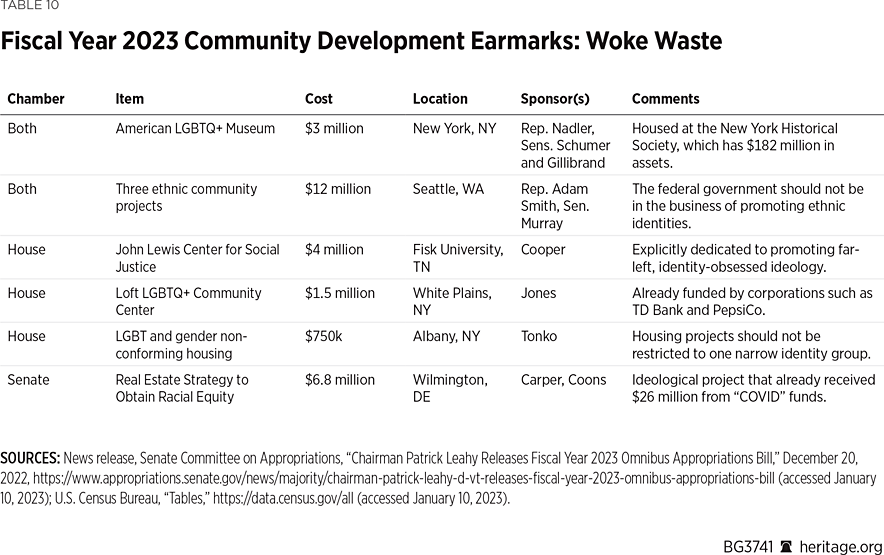
Finally, progressive Members of Congress are happy to use CDF earmarks to prop up their fellow travelers, as seen in the above table. A “racial equity” real estate project in Delaware is slated to net $6.8 million on top of a previous $26 million windfall from COVID-19 funds,REF and several LBGT groups would receive federal largesse.
Using taxpayer funds to shower millions of dollars on activist groups and projects that promote divisive identity politics is not merely wasteful but also profoundly unjust. If private donors are interested in funding such projects, that would be their choice. However, federal taxpayers should not be forced to directly fund radical ideologues.
It is difficult to think of federal spending that is more deserving of elimination than the CDF, which is a poor use of national resources during normal times and completely inexcusable at a time of skyrocketing debt and interest rates. Removing CDF earmarks would do a tremendous amount of good—but not as much as removing the CDF altogether.
Similar Flaws in Other Earmarked Programs
While the programs and earmarks highlighted above represent the worst of the worst, additional programs with a high volume of earmarks also deserve scrutiny. The following programs represent billions of dollars per year in handouts for state and local government responsibilities, unfair and arbitrary subsidies, and inefficient federal micromanagement. They should be significantly reformed or eliminated.
Department of Justice Grants for Local Policing. Located in the Commerce subcommittee bill, the Community Oriented Policing Services (COPS) program and the Byrne Memorial Justice Assistance Grant program act as slush funds to subsidize local police and anti-crime services. There should be no doubt that maintaining public safety is a core responsibility of local governments. However, providing haphazard subsidies for local police and anti-crime initiatives is a poor use of federal funds. It rewards localities for under-investing in public safety, enables initiatives with highly uneven (and sometimes negative) results, and adds a pointless layer of bureaucracy with the grant application and approval process.REF
Army Corps of Engineers. The Army Corps, which is funded through the Energy subcommittee bill, manages water infrastructure such as locks, dams, and waterways. It has been a victim of significant mission creep, as lawmakers now primarily view the Army Corps as a vehicle for pork projects.REF There is now a lengthy backlog of Army Corps projects, with legislators seeking credit for projects obtaining initial legislative approval while defunding older approvals languishing in the queue.REF Projects often have little or nothing to do with maintaining nationally significant waterways and are burdened by federal red tape such as the Foreign Dredge Act.REF The Army Corps requires significant reform, including the removal of inappropriate earmarks from both authorization and appropriation legislation.
Federal Emergency Management Agency (FEMA) Preparedness Grants. FEMA, which is funded through the Homeland Security subcommittee bill, manages federal involvement in disaster situations. Regrettably, the policy trend has been toward having the federal government take over funding for disaster preparedness nationwide, resulting in tremendous amounts of waste and dysfunction.REF This is also a subsidy to disaster-prone regions, which perversely acts to encourage development in high-risk areas. The Emergency Operations Center and Pre-Disaster Mitigation grant programs are subject to a high number of appropriations earmarks and are an exercise in shifting local costs to the federal government.
Department of Labor Job Training Programs. Located in the Labor subcommittee bill, federal job-training programs are a perennial political favorite. Sadly, the track record of dozens of disparate federal training efforts has been lackluster, with program costs far exceeding earnings benefits for participants.REF In some cases, workers who participate in federally funded training programs ultimately receive less compensation than peers who do not participate.REF Since the purpose of federal job training programs is to increase employment and earnings among participants, failure to meaningfully help participants on average makes these programs wasteful. Earmarks for new local training initiatives are no more likely to succeed than previous failures. Congress should recognize that allocating billions of dollars per year to failing job training is throwing good money after bad and is something the nation can no longer afford.
Airport Grants. The federal government takes from the aviation sector through a tax on airline tickets and “gives back” through heavily micromanaged and regulated grants in the Transportation subcommittee bill.REF The federal limit on Passenger Facility Charges, which airports use to pay for their own infrastructure needs, makes airports dependent on federal handouts.REF Legislators seek to justify earmarks for airports as returning money that was originally taken from passengers by the federal ticket tax. However, airport earmarks still serve to perpetuate a broken status quo, with legislators pretending to be aviation saviors while keeping the sector in shackles.
Crimson Corruption and Green Mountain Greed: Taxpayer-Funded Retirement Gifts
Senator Richard Shelby (R–AL) received over half a billion dollars in 2022 earmarks, including $100 million for Mobile’s modest airport, over 10 times as much as any other airport in the country.REF It is not a coincidence that Senator Shelby directed a massive amount of taxpayer resources while serving as the ranking Republican on the Senate Appropriations Committee.REF
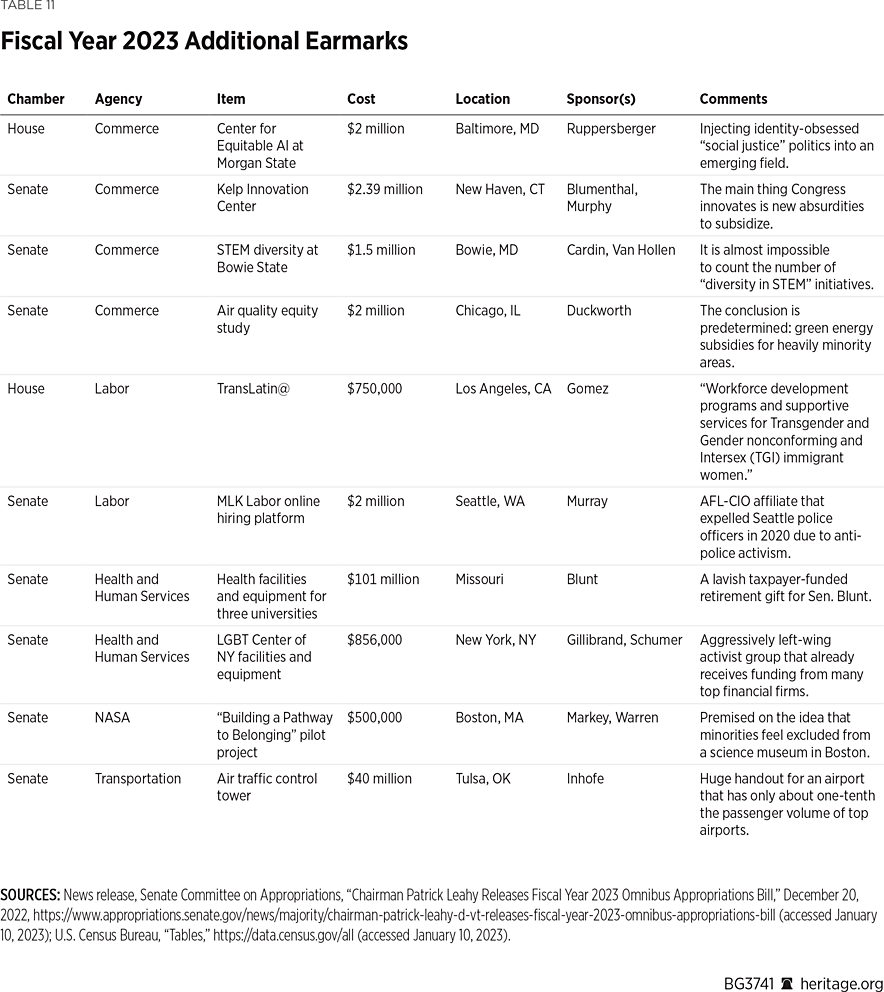
The story is much the same for FY 2023 earmarks. Senator Shelby retained the title of Top Porker by raking in $666 million,REF with several earmarks standing out as particularly egregious:
- The State of Alabama’s Port Authority, which covers rail and shipping infrastructure, received $200 million. This does not even pretend to prioritize a significant project but is instead welfare for the state government.
- The Woolsey Finnell Bridge in Tuscaloosa received $100 million for a replacement. Although it is an important bridge to the city, it is not an especially vital bridge for the region, let alone the country. Directing such a disproportionate share of federal funding to the project is raw favoritism and another handout to the state.
- The City of Mobile received a $50 million “revolving loan fund” for “economic” projects. The terminology used is so broad that this should be seen as another slush fund.
- The small, low-traffic airports in Tuscaloosa and Abbeville received $26 million and $13 million, respectively, for runway extensions. The Abbeville project is especially wasteful, as Abbeville has a population of 2,500 and the nearest population center (Dothan) has its own airport.
The top Democrat recipient of FY 2023 earmarks was Senator Patrick Leahy (D-VT), chairman of the Senate Appropriations Committee.REF Although Senator Leahy’s total earmark windfall is smaller than Senator Shelby’s, the State of Vermont received a much larger amount per person due to its tiny population. Vermont’s pork menu includes:
- A $34 million earmark for Burlington’s airport, the largest airport earmark despite Burlington ranking 135th in passenger volume in 2021.REF
- A project seeking to make it easier for Burlington residents to walk to a local market received $12 million. Any amount would be an inappropriate use of federal funds, but $12 million is an astronomical sum for such a seemingly unambitious endeavor.
- Two earmarks totaling $2.35 million are for the Leahy Center for Lake Champlain. Senator Leahy directing public funds to an organization named in his honor is unseemly to say the least.
Senators Shelby and Leahy retired at the end of the congressional session. The Senators, both of whom spent over 35 years in the chamber, are set to receive comfortable pensions for the rest of their lives. They did not need a nine-figure amount of earmark spending for their states as an additional “gift” for their retirements, especially when so many American families are struggling to make ends meet in part because of excessive federal spending.REF
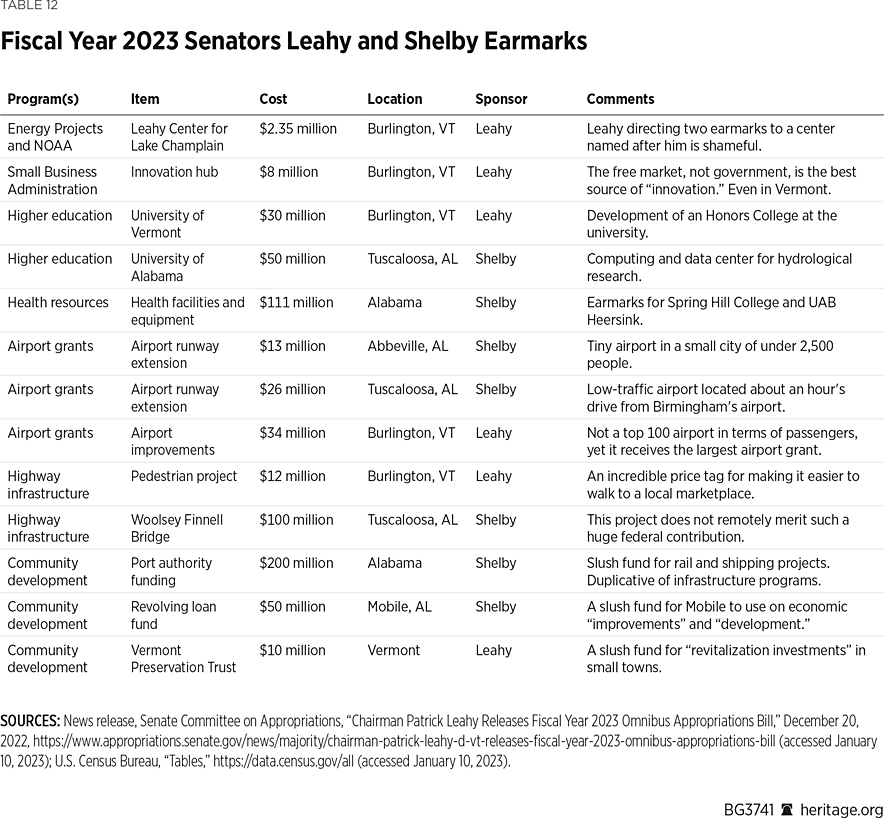
If Congress decides to finally take fiscal responsibility seriously, it should start at the top by ending the practice of allowing appropriators to give themselves plus-sized portions of earmarks.
Responding to Standard Earmark Excuses
Proponents of the earmarking practice claim that earmarks are justified as a way for Congress to reassert its authority over spending and as a way around partisan gridlock.REF However, there are many flaws with these lines of reasoning:
- The bulk of federal spending goes toward mandatory benefit programs that largely operate on autopilot and toward “zombie” programs whose authorizations have expired.REF If legislators were truly concerned about the balance of power between the legislative and executive branches (rather than doling out political favors), they would make a concerted effort toward reining in mandatory and unauthorized spending. As if to emphasize the point, Congress recently chose to shift a substantial portion of Veterans Affairs spending from discretionary to mandatory in the Honoring Our PACT Act of 2022, reducing the control of future legislators over an important federal responsibility.REF
- While legislators tend to be more familiar with their states and districts than federal bureaucrats are, this does not remotely prove that earmark spending is an absolute good. Federal elected officials are theoretically chosen to address federal issues based on local preferences, whereas state and local elected officials are chosen to directly address state and local issues. In addition to the many inefficiencies described earlier in the paper, federal earmarks for local projects represent federal infringement on state and local power and responsibility.REF Even if local officials lobby for an earmark, in the process they become a subsidiary of the federal government, which is not a healthy development for local governance.
- The rise of earmarks coincided with a breakdown of the budget and appropriations process rather than an improvement. Congress has not passed all 12 appropriations bills on time since 1994, and the 2006 peak of earmarking activity only saw a single bill pass on time.REF FY 2022 appropriations passed as a massive omnibus in March 2022—over five months late—despite the return of earmarks.REF Similarly, FY 2023 appropriations missed the September 30 deadline.REF
- To the extent that earmarks potentially make it easier to pass legislation, that does not mean they represent healthy democratic activity. Instead, earmarks are a textbook example of logrolling, a practice where many disparate items of spending (or tax loopholes) are bundled together to obtain majority support, even if many or most of the items would not receive majority support on their own.REF Copious quantities of earmarks are an enabler of the unfocused, overspending monstrosity that the federal government has devolved into and are a way to reward Members for maintaining a dysfunctional status quo.REF
It is vital for proponents of a functional legislative branch and healthy democratic order to recognize that earmarks promote corrupt self-dealing, help to perpetuate harmful federal bloat, and undermine proper local governance that was a hallmark of American democracy at the time of the nation’s founding.
Conclusion
America faces a very real reckoning in the near future due to the federal government’s unprecedented peacetime accumulation of debt and unfunded liabilities.REF Members of Congress will face many difficult choices regarding benefit programs, tax levels, interest payments, and more over the next few years.
For the sake of America’s future prosperity, legislators must start making responsible decisions. Getting rid of wasteful, corrupt, and inappropriate spending such as earmarks and hyper-local grant programs in the appropriations process would send a strong signal that Congress is finally ready to start doing the right thing.
David A. Ditch is a Policy Analyst in the Grover M. Hermann Center for the Federal Budget at The Heritage Foundation.


